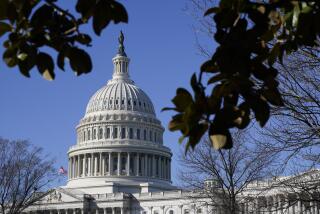Foes Say Mailers Help Incumbents : Franking: A study shows that Reps. Gallegly and Lagomarsino spent $185,179 and $121,457 in 1989 on what a challenger calls self-aggrandizement.
- Share via
Democratic challengers on Friday accused Congressmen Elton Gallegly and Robert J. Lagomarsino of using taxpayer-supported mailers to strengthen their 1990 reelection campaigns, and of being among the biggest spenders in the House of Representatives on newsletters to constituents.
Gallegly (R-Simi Valley) spent $185,179 and Lagomarsino (R-Ventura) $121,457 on mass mailings in 1989, which ranked them fifth and 14th among California’s 44 House members in 1989, says a new study by a national taxpayers group.
Citing that study and her own analysis of mailings this year, Anita Perez Ferguson said Friday that Lagomarsino has spent $289,000 over the last two years on mailers.
“My concern is that this is basically self-aggrandizing junk mail,” Ferguson, a former aide to state Sen. Gary Hart (D-Santa Barbara), said after a Ventura news conference.
Richard D. Freiman, an Agoura attorney and TV writer opposing Gallegly, said the incumbent’s reported spending on five mass mailings in 1989 was a waste of money.
“These are puff pieces for Gallegly,” he said. “Most people throw them out because they don’t have any information that is important or necessary in them.”
Controversy surrounding the so-called franking privilege, under which Congress spent more than $100 million last year on mailings, led to extensive reform in the U.S. Senate in 1989 and to lesser restrictions in the House of Representatives.
Spokesmen for Lagomarsino and Gallegly said the congressmen both supported those reforms, voting to reduce the number of mass mailings by House members from six to three a year beginning in 1990.
Lagomarsino “would have supported eliminating them completely” if that had come to a vote, said John Doherty of the congressman’s Washington staff.
Lagomarsino and Gallegly voted to limit the mail privilege--a popular congressional benefit since 1793--even though both remain convinced that the newsletters are useful tools in communicating with constituents, their spokesmen said.
“The congressman believes it’s an important way of keeping in touch with the district,” said John Frith, Gallegly’s press secretary.
Frith and Doherty said surveys have shown repeatedly that residents of their districts like the newsletters and want them to continue. They said, however, that only about 10% to 15% of households in their districts respond to such surveys.
“As long as it’s there and our constituents want to have it, we’ll keep using it,” Doherty said.
The cost of mass mailings by Gallegly and Lagomarsino, who represent the two congressional districts that overlap Ventura County, was reported late last month by the National Taxpayers Union, a 200,000-member nonprofit group that lobbies for reduced government spending.
Bill Pierce, spokesman for the group, said the study shows that the average expense by a congressman on newsletters in 1989 was 31 cents per household. By comparison, Lagomarsino spent 37 cents for each household in his district and Gallegly 71 cents, Pierce said.
Pierce said the figures in his group’s study are not precise, because the exact spending of House members on mass mailings are confidential. But most, including Gallegly and Lagomarsino, confirmed the number of mailings from their offices. A minimum figure was derived from that.
Frith acknowledged that Gallegly sent five of the six mass mailings allowed in 1989, as reported in the study. But he said it is somewhat flawed because it is not exact.
Doherty said Lagomarsino did send three mass mailers in 1989, as reported in the study. But he challenged Ferguson’s claim that the congressman had spent another $160,000 this year on six mass mailings. He said that Ferguson has no way of knowing how much Lagomarsino has spent and that he has sent out only three newsletters to all households in his district.
Three additional mailings were sent out over the summer to thousands of people who have expressed concern about specific issues, he acknowledged.
More to Read
Get the L.A. Times Politics newsletter
Deeply reported insights into legislation, politics and policy from Sacramento, Washington and beyond. In your inbox twice per week.
You may occasionally receive promotional content from the Los Angeles Times.










